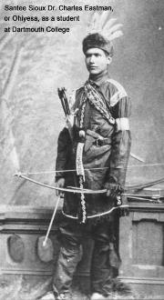Likely one of the least known of Scouting’s founders here in America, Charles Eastman was an amazing man and an amazing American. He was the first Native American to be certified in Western medicine and was “one of the most prolific authors and speakers on Sioux ethnohistory and American Indian affairs” in the early 20th century.

Eastman was of Santee Dakota (Sioux), English and French ancestry. Eastman attended a mission then a preparatory school, Kimball Union Academy from 1882-1883, then college. He first attended Beloit College and Knox College; but graduated from Dartmouth College in 1887. He attended medical school at Boston University, where he graduated in 1890 and was among the first Native Americans to be certified as a European-style doctor. After working as a physician on reservations in South Dakota, he became increasingly active in politics and issues on Native American rights. He worked to improve the lives of youths, and founded thirty-two Native American chapters of the YMCA. He is considered the first Native American author to write American history from the Native American point of view. He also helped found the Boy Scouts of America. He served in various roles in several presidential administrations from Teddy Roosevelt in 1903 to Calvin Coolidge in 1923, always advocating for Native Americans.
Eastman was named Hakadah at his birth in Minnesota; his name meant “pitiful last” in Dakota. Eastman was so named because his mother died following his birth. However, In the Dakota tradition of naming to mark life passages, Hakadah was later named Ohíye S’a (Dakota: “always wins” or “the winner”). This was a much more fitting name.
Inspired by his writings, Ernest Thompson Seton sought Eastman’s counsel in forming the Woodcraft Indians, which became a popular group for boys. The New York YMCA asked both Seton and Eastman to help them design YMCA Indian Scouts for urban boys, using rooftop gardens and city parks for their activities. In 1910, Seton invited Eastman to work with him and Daniel Carter Beard to found the Boy Scouts of America (BSA). Luther Gulick also consulted with Eastman to assist him and his wife Charlotte to develop the Camp Fire Girls.
With his fame as an author and lecturer, Eastman promoted the fledgling Boy Scouts and Camp Fire Girls. He advised them on how to organize their summer camps, and directly managed one of the first Boy Scout camps along the shores of the Chesapeake Bay. In 1915, the Eastman family organized their own summer camp, Camp Oáhe, at Granite Lake, New Hampshire, where the whole family worked for years. Eastman served as a BSA national councilman for many years.



